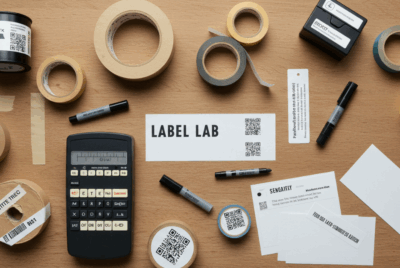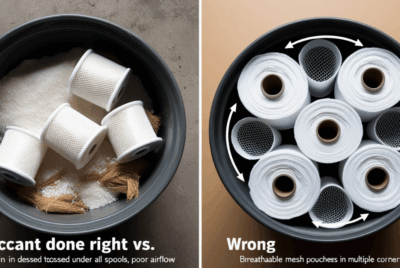How Does the Size of the Vacuum-Sealed Bag Affect Filament Storage?
The size of the vacuum-sealed bag plays a critical role in ensuring that your 3D filament is properly stored and protected from moisture and environmental factors. Using the right size vacuum bag can help maintain filament quality, avoid damage, and optimize the storage process. Let’s explore how the size of the vacuum-sealed bag affects filament storage.
1. Ensuring Proper Compression and Seal
- What It Means:
- Vacuum-sealed bags work by removing air from the bag to create an airtight environment. If the bag is too large for the filament, the vacuum process may not remove all the air, resulting in an ineffective seal and potential moisture exposure. Conversely, if the bag is too small, the filament could be compressed too tightly, which may cause deformation or damage to the spool.
- Why It Matters:
- A properly sized bag ensures that the filament is compressed just enough to remove the air without over-compressing it. This ensures a tight vacuum seal and helps maintain the filament’s shape and quality.
- How to Do It:
- Choose a bag size that fits the filament spool comfortably, leaving a small amount of space around the spool. For larger spools, use larger bags to avoid unnecessary pressure. For smaller spools, opt for smaller bags to achieve an efficient vacuum without excessive empty space.
- Benefit:
- Proper compression ensures a tight seal, preventing the filament from becoming misshapen or absorbing moisture during storage.
2. Preventing Filament Damage and Deformation
- What It Means:
- Using a vacuum-sealed bag that’s too small can cause the filament spool to become over-compressed, which can lead to deformation or flattening. When the spool is crushed, it can be difficult to unwind the filament and feed it properly into the 3D printer, causing extrusion issues and affecting print quality.
- Why It Matters:
- Filament spools are designed to be wound tightly, but they need some space to maintain their original shape. Over-compression can distort the spool and affect how smoothly the filament feeds into the extruder.
- How to Do It:
- Always check the size of the bag relative to the size of your filament spool. Ensure the bag isn’t too tight or overly large. A moderate vacuum will remove enough air without over-compressing the filament.
- Benefit:
- Maintaining spool shape ensures easy filament use and prevents problems like tangling or feeding issues.
3. Maximizing Space Efficiency
- What It Means:
- When storing multiple spools, choosing the right size vacuum-sealed bag can maximize space efficiency. Too much extra space in a bag can lead to ineffective sealing, while too little space can cause spool deformation as mentioned earlier.
- Why It Matters:
- If you’re storing multiple spools of filament, selecting the right bag size allows you to fit the spools efficiently without wasting space. Conversely, using a bag that is too large for a single spool may result in an inefficient vacuum, reducing the bag’s effectiveness.
- How to Do It:
- For multiple spools, choose a larger vacuum bag that allows you to arrange the spools properly without excess air inside. If storing individual spools, choose a bag that fits the spool snugly without unnecessary space.
- Benefit:
- Proper bag size ensures efficient storage of multiple spools while maintaining a strong vacuum seal.
4. Ensuring Consistent Moisture Control
- What It Means:
- Moisture protection is one of the primary reasons for vacuum-sealing filament. A properly sized vacuum bag ensures that there is no excessive air in the bag, allowing desiccants inside to absorb moisture effectively. If the bag is too large, the moisture control may be less effective, as the desiccant will have to work harder to maintain a dry environment:
- Why It Matters:
- The desiccant’s job is to absorb moisture from the air inside the bag, and if the bag is too large, the desiccant might not have enough surface area in contact with the air to effectively control humidity.
- Use appropriately sized bags that allow the desiccant to absorb moisture efficiently, with minimal empty space for moisture to accumulate.
- Benefit:
- Better moisture control ensures that the filament remains dry and in optimal condition, preventing moisture-related issues like bubbling, weak adhesion, and poor print quality.
5. Impact on Bag Sealing Efficiency
- What It Means:
- If the vacuum-sealed bag is too large, it can be harder to achieve a tight, uniform seal, which is essential for moisture protection. Conversely, if the bag is too small, it may be difficult to create a proper vacuum due to the excessive pressure on the filament.
- Why It Matters:
- A bag that is too large will not remove enough air, leading to an ineffective seal. A bag that is too small could result in over-compression, causing deformation or damage to the filament.
- How to Do It:
- Choose the right size bag to ensure the optimal vacuum can be achieved. You want the vacuum-sealer to remove as much air as possible without over-compressing the filament.
- Benefit:
- Strong, airtight seals ensure that your filament is protected from external elements and maintains its quality during storage.
6. The Effect of Bag Size on Sealing Time
- What It Means:
- The larger the bag, the longer it may take to remove the air and achieve an airtight seal. This is particularly relevant when sealing multiple spools in one bag. The larger the bag, the more time and energy it takes to vacuum seal it completely.
- Why It Matters:
- Sealing efficiency can be affected by bag size. If the bag is too large, the vacuum process might not be as efficient, requiring additional effort or multiple attempts to achieve a proper seal.
- How to Do It:
- Avoid overly large bags that could complicate the sealing process. For multiple spools, make sure the bag is large enough to accommodate them without leaving too much extra space.
- Benefit:
- Efficient sealing helps maintain the effectiveness of the vacuum-sealing process and reduces the chances of the bag not sealing properly.
7. Impact on Storage Conditions
- What It Means:
- The bag size can also impact how easy it is to store the vacuum-sealed bag. Large bags may take up more space in your storage area, while smaller bags can be stored more compactly.
- Why It Matters:
- Space efficiency is important, especially if you are storing multiple spools or need to stack the bags for easy access. Using the right bag size makes your storage more organized and efficient.
- How to Do It:
- Choose appropriately sized bags that maximize the use of available storage space, whether you’re storing one spool or several.
- Benefit:
- Organized storage allows you to keep your filament neatly stored and ensures that you can access it easily when needed.
Summary of How the Size of the Vacuum-Sealed Bag Affects Filament Storage:
- Proper Compression and Seal: A correctly sized bag ensures a tight, effective vacuum seal without over-compressing the spool.
- Preventing Filament Damage: A bag that’s too small can cause deformation, while a bag that’s too large can cause ineffective sealing.
- Space Efficiency: Proper bag size maximizes storage space while keeping filament safe and organized.
- Moisture Control: A bag that’s too large can reduce the efficiency of desiccants and compromise moisture protection.
- Sealing Efficiency: The right bag size ensures that the seal process is efficient, with minimal time and effort needed.
- Storage Conditions: Proper bag size makes filament storage more organized and space-efficient.
Conclusion:
The size of the vacuum-sealed bag plays a crucial role in the effectiveness of filament storage. A well-sized bag ensures a tight vacuum seal, protects the filament from moisture and physical damage, and makes the storage process more efficient. For the best results, always choose a bag that fits the filament spool comfortably, leaving just enough room to achieve a proper seal without over-compressing the spool. Properly sized vacuum bags will not only keep your filament safe but also make storage easier and more efficient.




